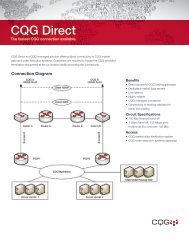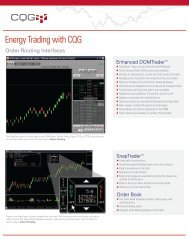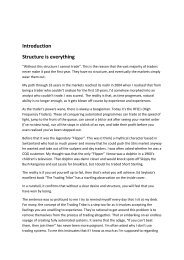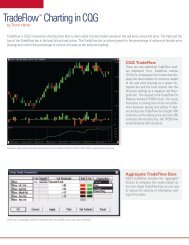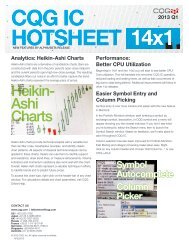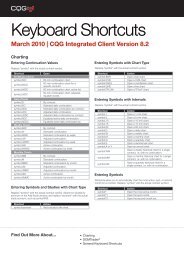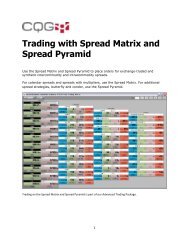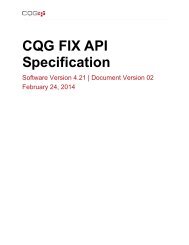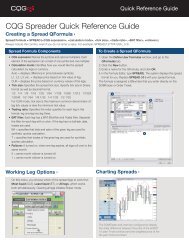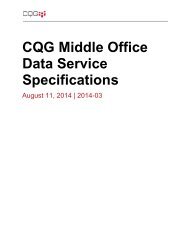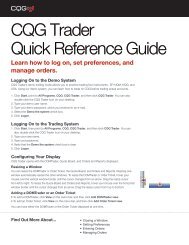Trading Time. - CQG.com
Trading Time. - CQG.com
Trading Time. - CQG.com
Create successful ePaper yourself
Turn your PDF publications into a flip-book with our unique Google optimized e-Paper software.
Volatility <strong>Time</strong> Averages<br />
Volatility <strong>Time</strong> Averages treats each individual bar only in connection to the same bar<br />
the previous days. The average range is <strong>com</strong>puted over a user defined range. Then the<br />
highest and lowest value of range for that time of day is <strong>com</strong>puted over the last 1000<br />
bars. The difference between the current ranges over n bars is recorded against the<br />
highest range over the last 1000 bars and depending on the difference an exponential<br />
moving average is calculated. This average is given a user defined minimum and<br />
maximum range of average which defaults between a 3 and 21 period. The conclusion is<br />
that if range is narrow in relationship to the history of that time of day the average slows<br />
but if range is large the average speeds up.<br />
Volatility <strong>Time</strong> Bands<br />
Removing the variable of the average and replacing it with a variable that looks at each<br />
specific time of day to previous days, enables a set of bands that maintain there flexibility<br />
to market changes. They are called Volatility <strong>Time</strong> Bands. As soon as the bar opens the<br />
average range for that time of day is <strong>com</strong>puted and 1, 2 and 3 standard deviations are<br />
placed on either side of the market. The use of the opening is critical in that it provides a<br />
predictive framework as the values are fixed and lead to the ability to analyze on a<br />
multitude of concepts.<br />
One of the key criteria is being able to understand what is the limit of range within one<br />
aspect of time. Whilst 1 timeframe can be used in isolation, extra power can be obtained<br />
with multiple timeframe confirmation. The 3 charts on Bunds show a confluence of<br />
extremes as the 30 minute chart has a extreme 3 rd deviation low at 109.90, which is also<br />
the limit of range in the 15 minute and as low as the 5 min. When this is used in<br />
<strong>com</strong>bination with true measure of support and resistance with Market Profile, not only<br />
can day trading turning points be found, but also major strategic turning points in trend.<br />
This is given even more strength when the Kase Peak Oscillator is showing an oversold<br />
scenario as seen in the 15 minute chart. At such times, for both the short term trader and<br />
strategic players risk can be defined as low as 3 ticks on Bunds. This is due to the<br />
connection between macro picture supports and resistance and micro picture limits of<br />
range and allows for far higher volume to be traded as position sizing and subsequently<br />
risk reward ratios explode upwards.



